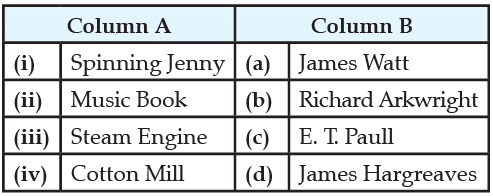Assertion & Reason Test: The Age of Industrialisation - Class 10 MCQ
15 Questions MCQ Test - Assertion & Reason Test: The Age of Industrialisation
Match the following items given in Column A with those in Column B:


Match the following items given in Column A with those in Column B:




Arrange the following in the correct sequence:
(i) James Hargreaves invented the Spinning Jenny
(ii) James Watt patented the Steam Engine.
(iii) Richard Arkwright created the First Cotton Mill.
(iv) Matthew Boulton Manufactured the new model of Steam Engine.
Arrange the following in the correct sequence:
(i) J. N. Tata set up the first iron and steel plant in Jamshedpur.
(ii) Dwarkanath Tagore set up six joint stock companies in Bengal.
(iii) Seth Hukumchand set up the first jute mill in Calcutta.
(iv) Music Publisher E. T. Paull produced a music book.
Analyse the information given below, considering one the following correct options:
The abundance of labour in the market affected the lives of workers. As news of possible jobs travelled to the countryside, hundreds tramped to the cities. The actual possibility of getting a job depended on existing networks of friendship and kin relations. If you had a relative or a friend in a factory, you were more likely to get a job quickly. But not everyone had social connections. Many jobseekers had to wait weeks, spending nights under bridges or in night shelters. Some stayed in Night Refuges that were set up by private individuals; others went to the casual wards maintained by the Poor Law authorities.
Analyse the information given below, considering one the following correct options:
By the late nineteenth century, manufacturers were printing calendars to popularise their products. Unlike newspapers and magazines, calendars were used even by people who could not read. They were hung in tea shops and in poor people’s homes just as much as in offices and middle-class apartments. And those who hung the calendars had to see the advertisements, day after day, through the year. In these calendars, once again, we see the figures of Gods being used to sell new products. Like the images of gods, figures of important personages, of emperors and nawabs, adorned advertisement and calendars. The message very often seemed to say: if you respect the royal figure, then respect this product; when the product was being used by kings, or produced under Royal command, its quality could not be questioned.
Assertion and Reason Type Questions:
In the questions given below, there are two statements marked as Assertion (A) and Reason (R). Read the Statements and choose the correct option :
Assertion (A) : European Managing Agencies, which dominated industrial production in India, were interested in certain kinds of products.
Reason (R) : They established tea and coffee plantations, acquiring land at cheap rates from the Colonial Government; and they invested in mining, indigo and jute.
Assertion and Reason Type Questions:
In the questions given below, there are two statements marked as Assertion (A) and Reason (R). Read the Statements and choose the correct option:
Assertion (A) : The most dynamic industries in Britain were clearly Cotton and Metals.
Reason (R) : By 1873, Britain was exporting iron and steel worth about £ 77 million, double the value of its cotton export.
Direction: Mark the Option Which Is Most Suitable:
Assertion : When Manchester industrialists began selling cloth in India, they put labels on the cloth bundles.
Reason : The label was a mark of Quality. When buyers saw ‘MADE IN MANCHESTER’ written in bold on the label, they were expected to feel confident about buying the cloth.
Direction: Mark the Option Which Is Most Suitable:
Assertion : The consolidation of East India Company power after the 1760s did not initially lead to a decline in textile exports from India.
Reason : British cotton industries had not yet expanded and Indian fine textiles were in great demand in Europe.
Direction: Mark the Option Which Is Most Suitable:
Assertion : In most industrial regions, workers came from the districts around.
Reason : Peasants and Artisans who found no work in the village went to the industrial centres in search of work.
Direction: Mark the Option Which Is Most Suitable:
Assertion : In the twentieth century, handloom cloth production expanded steadily.
Reason : This was partly because of technological changes,
Direction: Mark the Option Which Is Most Suitable:
Assertion : Like the images of gods and goddesses, figures of important personages like emperors and nawabs adorned advertisements and calendars.
Reason : This was done to show the pomp and glory of the nation.














